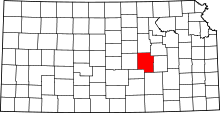Waldeck, Kansas
| Waldeck, Kansas | |
|---|---|
| Ghost town | |
 KDOT map of Marion County (legend) | |
 Waldeck | |
| Coordinates: 38°25′44″N 97°19′37″W / 38.42889°N 97.32694°WCoordinates: 38°25′44″N 97°19′37″W / 38.42889°N 97.32694°W[1] | |
| Country | United States |
| State | Kansas |
| County | Marion |
| Township | Lehigh |
| Platted | 1899 |
| Elevation[1] | 1,555 ft (474 m) |
| Population | |
| • Total | 0 |
| Time zone | CST (UTC-6) |
| • Summer (DST) | CDT (UTC-5) |
| Area code | 620 |
| FIPS code | 20-74540 [1] |
| GNIS ID | 484810 [1] |
|
| |
Waldeck was an unincorporated community in Marion County, Kansas, United States.[1] It is currently a ghost town that was located approximately 3.5 miles north of Lehigh next to a railroad.[2] No buildings remain of this former community.
History

Early history
For many millennia, the Great Plains of North America was inhabited by nomadic Native Americans. From the 16th century to 18th century, the Kingdom of France claimed ownership of large parts of North America. In 1762, after the French and Indian War, France secretly ceded New France to Spain, per the Treaty of Fontainebleau.
19th century
In 1802, Spain returned most of the land to France. In 1803, most of the land for modern day Kansas was acquired by the United States from France as part of the 828,000 square mile Louisiana Purchase for 2.83 cents per acre.
In 1854, the Kansas Territory was organized, then in 1861 Kansas became the 34th U.S. state. In 1855, Marion County was established within the Kansas Territory, which included the land for modern day Waldeck.[3]
From the 1820s to the 1870s, one of the most significant land routes in the United States was the Santa Fe Trail. The Santa Fe Trail was active across Marion County from 1821 to 1866.[4] Along the Santa Fe Trail, French Frank's Road Ranch and Cottonwood Holes (for watering) were original located on the land south of 245th Street. A Santa Fe Trail marker is located on the trail near Waldeck on 245th Street.[5]
Also, the Chisholm Trail crossed Marion County from 1867 to 1871. Amazingly, Waldeck was near the junction of the Santa Fe Trail and Chisolm Trail, possibly within 1 mile.[6]
In 1887, the Chicago, Kansas and Nebraska Railway built a main line from Herington through Waldeck to Pratt.[7] In 1888, this line was extended to Liberal. Later, it was extended to Tucumcari, New Mexico and El Paso, Texas. It foreclosed in 1891 and taken over by Chicago, Rock Island and Pacific Railway, which shut down in 1980 and reorganized as Oklahoma, Kansas and Texas Railroad, merged in 1988 with Missouri Pacific Railroad, and finally merged in 1997 with Union Pacific Railroad.
The town was most likely named by a Swiss Brethren after the former Waldeck sovereign principality in the German Empire. The land on which Waldeck would stand was sold to the Golden Belt Town Co in October 1887. The railroad was routed through the land and a depot was built, but the "boom spirit" of the 1880s turned downward, so the land was sold at a loss to the Kansas Town and Loan Company in the 1890s. A town with two block where platted on December 7, 1899. A small general store and school were located in the community, but the town didn't grow.[8]
21st century
Currently no buildings exist in Waldeck, thus it's considered a Ghost Town. There is a Santa Fe Trail marker nearby on 245th Street.
Geography
Waldeck was located at 38°25′44″N 97°19′37″W / 38.42889°N 97.32694°W,[1] located on the north side of 245th Street between Bison Road and Chisholm Trail Road in Marion County, Kansas. It was bordered between 245th Street on the south side and the railroad on the north side. Its platted location was the NW 1/4 of Section 4, Township 19, Range 1. A Stock yard was located on the north side of the tracks.[8][9][10]
See also
- Lehigh Township, Marion County, Kansas (location of Waldeck)
- Historical Maps of Marion County, Kansas
Further reading
- Santa Fe Trail
- Marion County Auto Tour of the Santa Fe Trail; 2 pages. (Download 1MB PDF Flyer)
- The Story of the Marking of the Santa Fe Trail by the Daughters of the American Revolution in Kansas and the State of Kansas; Almira Cordry; Crane Co; 164 pages; 1915. (Download 4MB PDF eBook)
References
- 1 2 3 4 5 6 Geographic Names Information System (GNIS) details for Waldeck, Kansas; United States Geological Survey (USGS); October 13, 1978.
- ↑ Blackmar, Frank Wilson (1912). Kansas: A Cyclopedia of State History, Volume 2. Standard Publishing Company. p. 466.
- ↑ The History of Marion County and Courthouse
- ↑ History of the Cottonwood Crossing Chapter, Santa Fe Trail Association.
- ↑ 1997 Survey of DAR Markers in Kansas
- ↑ Detailed map of the Chisolm Trail through Kansas; Kansas Historical Society.
- ↑ Rock Island Rail History
- 1 2 Marion County Kansas : Past and Present; Sondra Van Meter; MB Publishing House; LCCN 72-92041; 344 pages; 1972.
- ↑ Atlas of Marion County Kansas - Lehigh Township (page 25); Geo A. Ogle & Co; 103 pages; 1902.
- ↑ Atlas of Marion County Kansas - Plat of Waldeck (page 32); Geo A. Ogle & Co; 103 pages; 1902.
External links
- Historical
- Marion County cemetery list, archive of KsGenWeb
- Marion County history bibliography, Marion County school bibliography, Kansas Historical Society
- Maps
